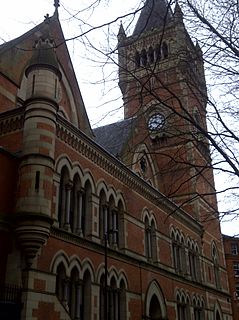Related Research Articles
Henry Gustave Hiller (1865–1946) was an artist based in Liverpool, England. He studied at the Manchester School of Art and is mainly known as a designer of painted gesso reliefs and stained glass.

The former Manchester Law Library is a Grade II* listed building in the Venetian Gothic style at 14 Kennedy Street, Manchester. The building is notable as having housed the oldest provincial law library in England. Its architect, Thomas Hartas, is little known, and the former Law Library appears to be his only documented building. In 2015 the Manchester Incorporated Law Library Society sold the premises, and moved to new offices on Booth Street.

The City Police Courts, commonly called Minshull Street Crown Court, is a complex of court buildings on Minshull Street in Manchester, designed in 1867–73 by the architect Thomas Worthington. The court was designated a Grade II* listed building on 3 October 1974.

The Peacock Mausoleum is a Victorian Gothic memorial to Richard Peacock (1820–1889), engineer and Liberal MP for Manchester, and to his son, Joseph Peacock. It is situated in the cemetery of Brookfield Unitarian Church, Gorton, Manchester. The mausoleum was designed by the prolific Manchester architect Thomas Worthington. It was listed Grade II* on the National Heritage List for England on 3 October 1974.

The Church of St Peter in Old Market Street, Blackley, Manchester, England, is a Gothic Revival church of 1844 by E. H. Shellard. It was a Commissioners' church erected at a cost of £3162. The church is particularly notable for an almost completely intact interior. It was designated a Grade II* listed building on 20 June 1988.
Joseph Stretch Crowther was an English architect who practised in Manchester. His buildings are mainly located in Manchester, Cheshire and Cumbria.

Greater Manchester is a metropolitan county in North West England. It was created by the Local Government Act 1972, and consists of the metropolitan boroughs of Bolton, Bury, Oldham, Rochdale, Stockport, Tameside, Trafford, Wigan and the cities of Manchester and Salford. This is a complete list of the Grade I listed churches in the metropolitan county as recorded in the National Heritage List for England. Buildings are listed by the Secretary of State for Culture, Media and Sport on the recommendation of English Heritage. Grade I listed buildings are defined as being of "exceptional interest, sometimes considered to be internationally important"; only 2.5 per cent of listed buildings are included in this grade.

Thomas Taylor was an English artist and architect. Although he did not achieve the reputation or the output of Thomas Rickman, he was another pioneer in the use of the Gothic Revival style in church architecture.

St Mary's Church is in St Mary's Street, Preston, Lancashire, England. It is a redundant Anglican parish church, and was converted into a conservation centre in 2006. The church is recorded in the National Heritage List for England as a designated Grade II listed building.
References
Citations
- ↑ Dixon & Muthesius 1985, p. 267.
- ↑ Port 2006, pp. 331–335.
- ↑ Hartwell, Hyde & Pevsner 2004, p. 55.
- ↑ Hartwell & Pevsner 2009, p. 545.
- ↑ Hartwell & Pevsner 2009, p. 510.
- ↑ "Family History Records".
- ↑ Manchester Courier and Lancashire General Advertiser. British Newspaper Archive. 3 February 1885. p. 6.
{{cite news}}: Missing or empty|title=(help)(subscription required)
Sources
- Dixon, Roger; Muthesius, Stefan (1985), Victorian Architecture (2nd ed.), London: Thames and Hudson, ISBN 978-0-19-520049-2
- Hartwell, Clare; Hyde, Matthew; Pevsner, Nikolaus (2004), Lancashire: Manchester and the South-East, The Buildings of England, New Haven and London: Yale University Press, ISBN 0-300-10583-5
- Hartwell, Clare; Pevsner, Nikolaus (2009) [1969], Lancashire: North, The Buildings of England, New Haven and London: Yale University Press, ISBN 978-0-300-12667-9
- Port, M. H. (2006), 600 New Churches: the Church Building Commission 1818–1856 (2nd ed.), Reading: Spire Books, ISBN 978-1-904965-08-4